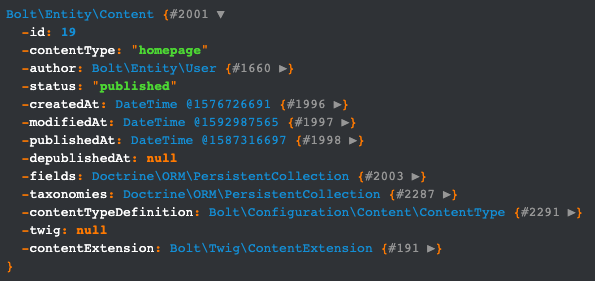Templating / Record and Records
Note: You are currently reading the documentation for Bolt 5.0. Looking for the documentation for Bolt 5.2 instead?
When writing templates for Bolt, you'll be mostly working with a single record with content, or arrays containing a number of records. See the page on ContentTypes for more information on how they become available in templates.
This page is divided in two parts: working with a single {{ record }}, or
with an array of {{ records }}. In the examples below we mostly refer to the
generic record variable, but in your own templates you're free to use the
proper name of the ContentType used.
Using a {{ record }}¶
The easiest way to see what the contents of a record (or any other variable,
for that matter) are, is to use the dump() function:
{{ dump(record) }}As you can see in the screenshot, a record of a ContentType is an object.
There are several benefits to this over a regular array. We can access the
fields like regular values, but we can also use specific functionality for
every object, without the need to define these separately.
In addition, Bolt ships with some Twig filters and functions to display the content and all its related fields and values.
You can access regular fields in a record like these examples for either a
page or entry record:
{{ page.title }}
{{ page.text }}
Created on {{ entry.createdAt|date('Y-m-d')}}
The ContentType for this entry is {{ entry.contenttype }},
and it contains {{ entry.fields.count }} fields.The real power comes from using the special functions that are defined for every content record.
To get a link to the content, use the link filter:
Link: <a href="{{ page|link }}">{{ page.title }}</a>Get a short excerpt of the record:
<p>{{ page|excerpt(250) }}</p>Get the next and previous record:
{% set previous = page|previous() %}
{% set next = page|next() %}The next and previous functions allow for additional parameters. For example, you can base the next record on the ID (the default), but you could also get the next page by publishing date.
{% set next = page|next('publishedAt') %}The complete list of available Twig filters for a record can be found here and here.
Getting the type of a certain field¶
If you're iterating over an array of record.fields, it's sometimes useful to
know what type of field you're dealing with. This is where the type
property comes in handy, it reads the fieldtype from the contenttypes.yaml
configuration file:
{% for field in record.fields %}
{% if field.type === "image" %}
<div class='imageholder-wide'><img src="{{ record.image|thumbnail(800, 600) }}"></div>
{% elseif field.type not in ['templateselect']
and key != "templatefields"
and value != "" %}
{{ value }}
{% endif %}
{% endfor %}Note: To create connections between different records of the same or different ContentTypes, see the page on Relations.
Using {{ records }}¶
The {{ records }} array is basically a set of several Content Records. When
you have a {{ records }} array, you can iterate over each of these records to
output them as desired. In the following example you can see how to get an array
of records. You'll notice that in this case it's not actually called records,
but pages. Since it's just a variable name, we can call it whatever we like.
After getting the {{ pages }} array, we use a conventional for loop, so we can
iterate over each of the separate {{ page }} records.
{% setcontent pages = 'pages' latest limit 4 %}
{% for page in pages %}
{# Do something with each {{ page }} #}
{{ page.title }}
{% endfor %}Because {{ records }} is an array, we can use all the regular Twig
functionality for arrays. In the previous example we've shown how to iterate
over the records using a for loop, but you can also do things like the
following.
Check how many records there are:
{% if pages|length > 0 %} More than 0 records {% endif %}
{% if pages|length < 5 %} Less than 5 records {% endif %}
There are exactly {{ pages|length }} records.Reverse the array:
{% for page in pages|reverse %}
{# Do something with each {{ page }} #}
{{ page.title }}
{% endfor %}Or slice the array:
{% set slice = pages|slice(1,3) %}
{% for page in slice %}
{# Do something with {{ page }} 1 through 3 #}
{{ page.title }}
{% endfor %}Use only the first or last record of the array with the first or last filters:
{% set firstrecords = records|first %}
The title of the first record is:
{{ firstrecord.title }}
Or directly, the last title:
{{ records|last.title }}Couldn't find what you were looking for? We are happy to help you in the forum, on Slack or on Github.
